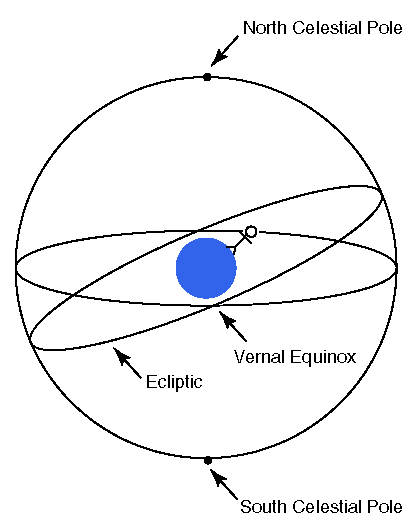

Thus during half the year the Sun is north of the celestial equator, and the Sun's daily path in the sky is like the red star on the below figure. It rises north of east, culminates high in the sky, sets north of west, and spends more than 12 hours above the horizon. This is summer in Minnesota. During the other half of the year the Sun's daily path is like the green star. It rises south of east, culminates below the celestial equator, sets south of west, and spends less than 12 hours above the horizon. This is winter in Minnesota.

The moments, two each year, when the Sun moves between hemispheres are called equinoxes; one happens around March 21, the other around September 21. The spring equinox (when the Sun moves from the southern hemisphere to the northern hemisphere) is called the vernal equinox


This is what the ecliptic looks like on the
sky map. Note that celestial equator is labeled, from the
vernal equinox going east, 1h, 2h, 3h...
this is the Right Ascension to be described on the next page.
The eastward ecliptic is labeled 15°, 30°, 45° ...
this is "celestial longitude" often denoted by the Greek letter lambda:
 .
The Sun slowly moves east on the ecliptic, increasing its celestial longitude
by about 1° per day. Notice that the Sun's motion on
celestial sphere in the opposite direction that the celestial sphere
rotates. Thus on the sky map, if we stopped the sphere's rotation
while the Sun was on the surface facing you, the Sun would be
slowly creeping to your left: eastward.
Since the creep of the Sun along the ecliptic (one rotation per
year) is so much slower than the daily rotation of the whole celestial sphere
(one rotation per day), the Sun is seen to move from east to west in our
sky.
.
The Sun slowly moves east on the ecliptic, increasing its celestial longitude
by about 1° per day. Notice that the Sun's motion on
celestial sphere in the opposite direction that the celestial sphere
rotates. Thus on the sky map, if we stopped the sphere's rotation
while the Sun was on the surface facing you, the Sun would be
slowly creeping to your left: eastward.
Since the creep of the Sun along the ecliptic (one rotation per
year) is so much slower than the daily rotation of the whole celestial sphere
(one rotation per day), the Sun is seen to move from east to west in our
sky.